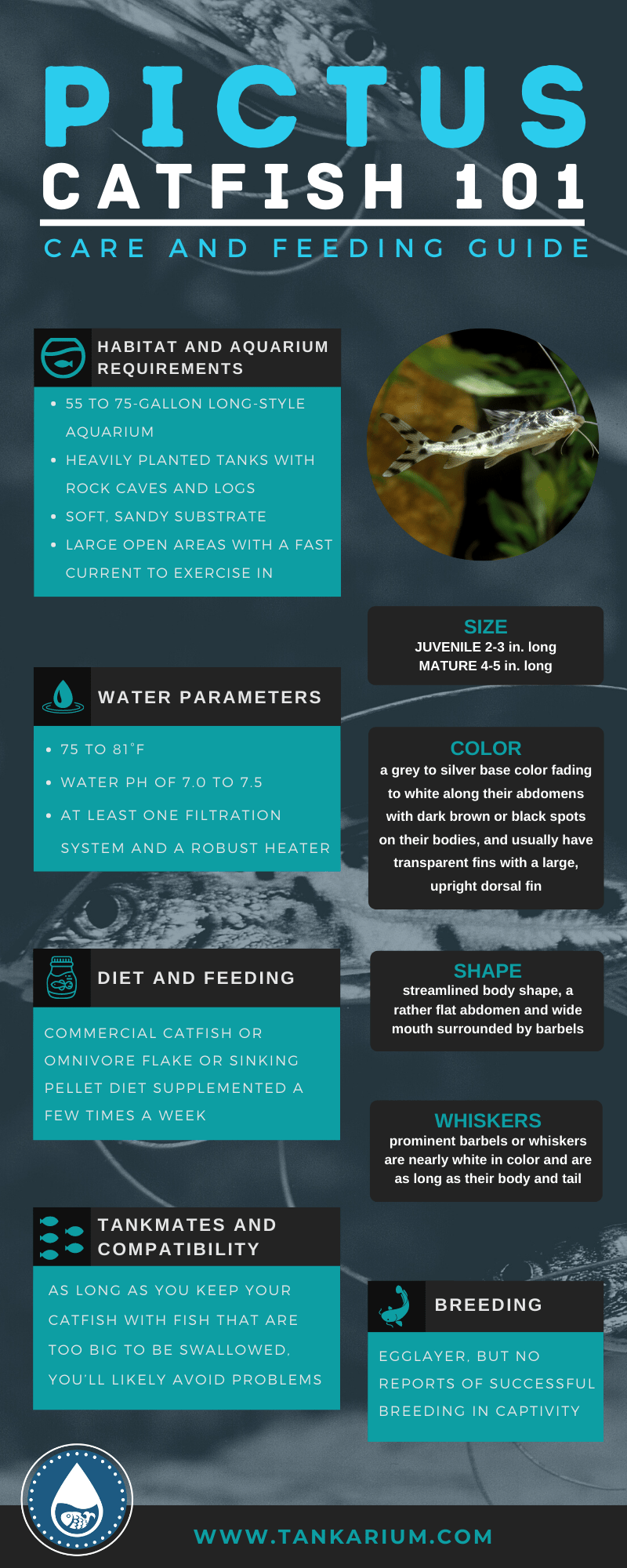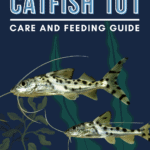If you’re looking for an entertaining scavenger for your planted tank then you should definitely check out the fabulous Pictus Catfish! These active and peaceful swimmers are one of the smallest freshwater catfish and make a lively addition to large community tanks. Here’s everything you need to know to raise Pictus Cats!
Introduction to the Spotted Pictus Catfish
Pictus cats (Pimelodus pictus) are one of the most popular catfish in the aquarium trade and have been for decades. While other catfish can be shy in aquariums, pictus cats are unusually outgoing and often willing to swim and explore during the day, especially if food is offered. Are these spotted silver catfish right for your tank?
Natural History of the Pictus Catfish
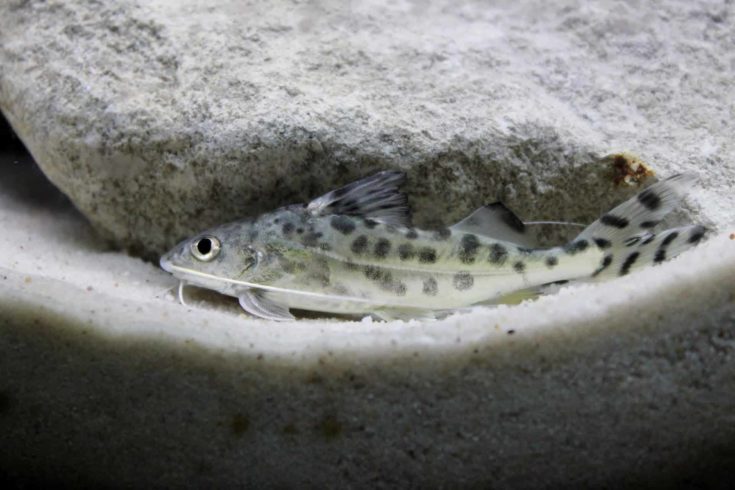
Pimelodella catfish are native to the Amazon River Basin and can be found in shallow freshwater streams throughout Brazil, Peru, Columbia, and Venezuela. They were first described by Franz Steindachner, an Austrian scientist and Harvard University professor who joined the Hassler expedition to South America in 1871.
Wild pictus cats live along the bottoms of fast-flowing streams and hide among the plants, rocks and logs when they are not hunting for food. Like most scavenging fish, pictus cats will eat anything they can fit into their mouths, but they are not highly aggressive and don’t usually attack small fish unless they are hungry.
How to Breed Pictus Catfish?
All the spotted catfish you’ll see for sale in aquarium stores and online are caught as eggs or fry in the wild and raised in captivity until they’re big enough for shipping, usually right around 2-inches in length. No one has ever successfully managed to breed pictus cats commercially.
We know they are an egg-laying fish, but beyond that, we know little about their spawning behavior or the conditions needed to encourage breeding. It’s likely that they need a very large heated pond or stream to mimic their natural habitat, but that’s all speculation until someone’s able to actually pull it off!
Pictus Catfish: Appearance and Temperament
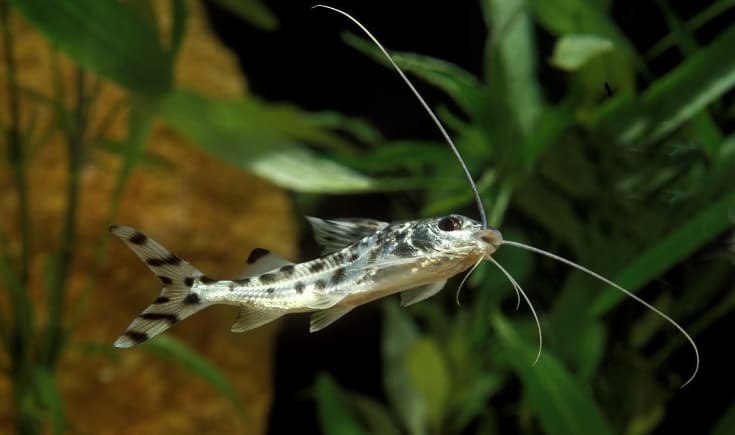
Spotted pictus cats are some of the most stunning catfish in the trade and look amazing in planted aquariums as they scavenge for food and swim through the currents. Honestly, once you’ve seen a pictus cat you’ll always recognize their distinctive appearance!
- Mature pictus cats are 4 to 5-inch long fish with a streamlined body shape, a rather flat abdomen and wide mouth surrounded by barbels.
- They have a grey to silver base color fading to white along their abdomens with dark brown or black spots on their bodies, and usually have transparent fins with a large, upright dorsal fin.
- Their prominent barbels or whiskers are nearly white in color and are as long as their body and tail.
Pictus cats use their long barbels to find their way through muddy water when swimming and looking for food. Their pectoral fins are sharp and serrated and easily get tangled in fishnets. It’s best to capture and transfer them in bowls of water instead of nets, to prevent injury to their fins.
How Large Do Pictus Catfish Grow and How Long Do They Live?
Pictus cats are usually sold as wild-caught juveniles when they are about 2 to 3 inches in length. In aquariums, they rarely grow over 5 inches but there are reports of fish that have reached 6-inches or longer in the wild.
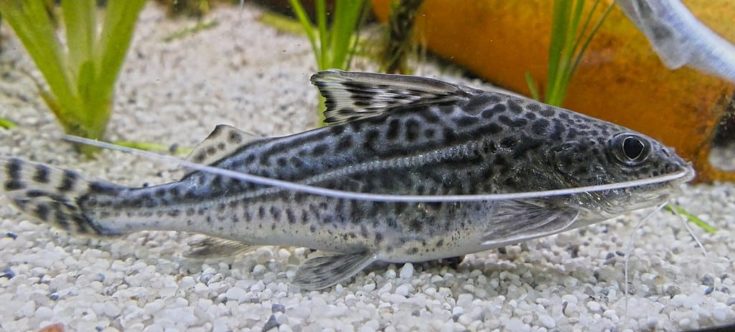
When raised in a roomy 55-gallon tank, a full-grown pictus cat will usually reach 4.5-inches in length. You’d likely have to provide a very roomy 200-gallon tank or larger if you want your pictus cats to reach their maximum potential. The typical lifespan of a pictus cat is about 8 years, but I had one that lived for a decade.
Pictus Cat Behavior
Pictus cats can be a bit of a contradiction in terms of their personalities and behavior. Like most catfish, pictus’ enjoy hiding among plants and exploring logs and rock caves along the bottom of your tank. But they are not shy like many of their cousins in the catfish family, and they need plenty of room to swim and explore too.
Pictus cats are naturally nocturnal and active at night, and they don’t care for the bright lights on many planted tanks. If you shade the open areas in your aquarium you’ll likely see your pictus cat swimming during the day. They are also highly food motivated and usually enthusiastically join the group at feeding time.
While these cats enjoy hiding at times, they are also very active swimmers who love to play in strong currents. My pictus cat, Glutton, loved to swim up and down the bubble wall at the end of my tank or in my filter outflows for the decade we had him. He’d do it for hours at a time and kept the entire house entertained with his antics.
Care and Feeding for Your Pictus Catfish
Pictus cats are not hard to care for as long as their primary needs are met, and they make a great option for novice aquarists or those new to keeping planted tanks. Let’s take a look at their ideal set-up and the conditions they need to thrive in your home aquarium!
Pictus Cat Habitat and Aquarium Requirements
The most common mistake beginners make with pictus cats is keeping them in tanks that are too small for their activity level or not providing them with enough current and open areas to swim. Pictus cats spend most of their time in the lower portions of your tank scavenging for food and are considered a bottom feeder.
Ideal Set-Up and Tank Size for Pictus Cats
Pictus cats prefer heavily planted tanks with rock caves and logs along the bottom, and do better with a soft, sandy substrate rather than a harsh gravel that could injure their delicate barbels. While they do spend some of their time hiding, they also need large open areas with a fast current to exercise in.
The ideal set-up for a single pictus cat is a 55 to 75-gallon long-style aquarium with live plants and natural rocks or branch decorations along the back and sides and open areas in the center. If you arrange your filter outflows, you can easily direct a steady current along the lower portions of the open areas for your catfish to enjoy.
Water Parameters: What Temperature Do Pictus Cats Prefer?
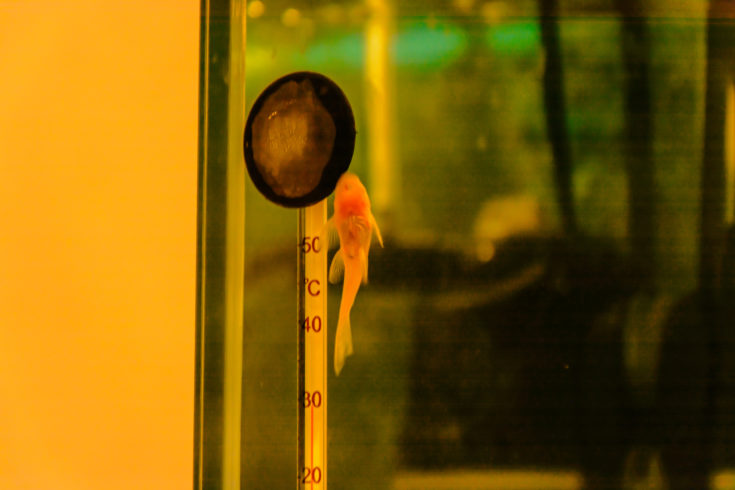
Pictus cats are tropical freshwater fish that prefer stable temperatures from 75 to 81°F. They do well with a water pH of 7.0 to 7.5 and are usually found in soft water in the wild. However, as long as your water hardness is stable and doesn’t shift, your fish should easily adjust to your local water conditions.
Pictus cats need heavily filtered, clean water that’s regularly changed. Since they also enjoy swimming in swift currents, canister filters are usually best for catfish communities since their outflows can be more easily adjusted. You’ll definitely need at least one filtration system and a robust heater for a catfish tank.
Can You Keep Pictus Cats Together?
Pictus cats will readily school and shoal together when kept in a group, but you can also keep a single catfish happily in your community tank. Pictus cats need at least 50-gallons of water each, so if you’d like to keep a group of three, you’ll need to get a tank that’s 150-gallons or larger for them.
Equipment Needed For a Catfish Tank
In the interest of keeping things simple, here’s a basic shopping list for setting up a tank suitable for a single pictus cat and a variety of other peaceful community fish:
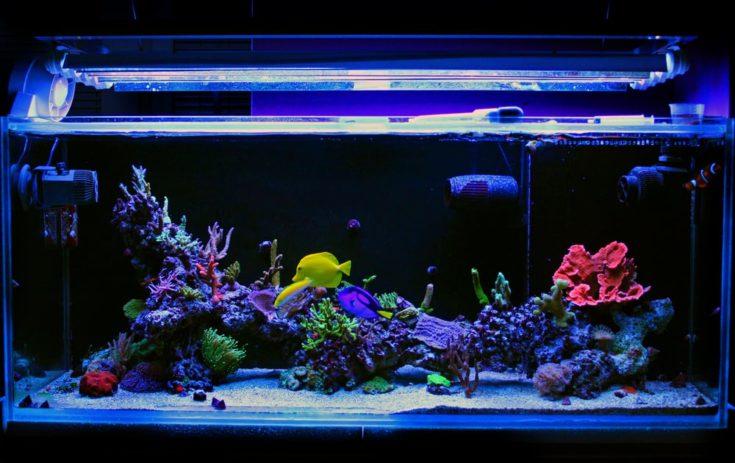
- 55-gallon aquarium with hood/cover/lights
- Sand or small gravel substrate
- Canister filter and filter media
- Aquarium heater
- Bubble wall or airstone and pump
- Live plants, rocks and logs
- Commercial catfish flakes or pellets
- Live/Frozen/Dried treats
Diet and Feeding: What Do Pictus Cats Eat?
Pictus cats are enthusiastic eaters and like most catfish, they are omnivorous scavengers that will eat anything they can swallow. There’s a reason we named our pictus cat “The Glutton.” He’d get so excited at meal times he’d grab flakes out of the other fishes mouths and eat until his stomach was distended!
The best food for your pictus cat is a commercial catfish or omnivore flake or sinking pellet diet supplemented a few times a week with algae wafers and live/frozen/dried treats such as brine shrimp, bloodworms, Daphnia eggs, and mosquito larvae. Pictus cats really enjoy live foods, so be sure to offer it to them at least occasionally.
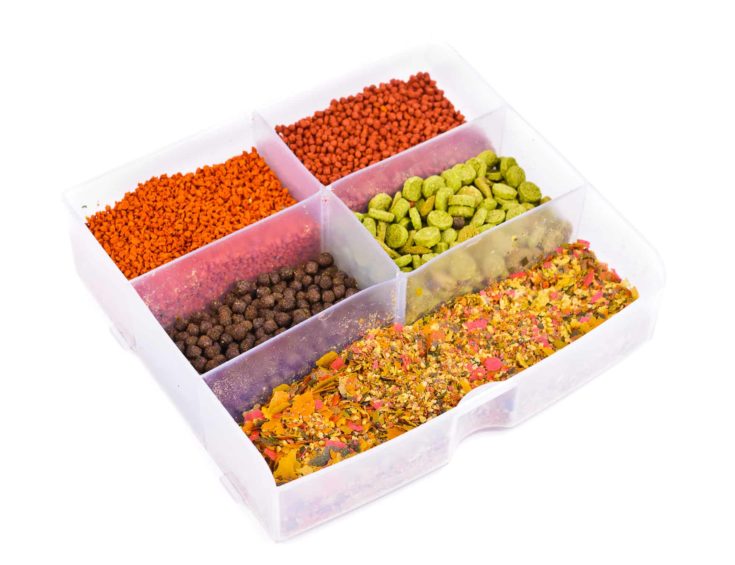
It’s best to feed your pictus cat every day, as these scavengers don’t deal well with fast days and might decide to snack on smaller fish instead. I usually offer them as much as they can eat in 2 minutes and then remove most of the leftovers. If you feed your fish on a regular schedule they will learn to come out for meal times!
Pictus Catfish Tank Mates and Compatibility
The key to having a community fish tank with a pictus cat is all about matching sizes. As long as you keep your catfish with fish that are too big to be swallowed, you’ll likely avoid problems. While they are not active predators, they will eat smaller fish like neon tetras as readily as their commercial diets!
There’s a wide variety of suitable species for pictus tanks, so look for large, peaceful community fish such as:
- Zebra Danios
- Gold or Cherry Barbs
- Gourami
- Rainbowfish
- Mollies and Platies
Pictus cats also usually get along well with other catfish like Upside-Downs, Otocinclus, and Plecostomus. Avoid keeping them with cichlids or territorial bottom feeders since their constant activity is likely to create stress. I’ve kept pictus cats with a few species of freshwater sharks as well, so you have a lot of options.
Quick Pictus Cat Care Sheet
| Scientific Name | Pimelodus pictus |
| Common Name | Pictus Catfish, Pictus Cat, Angel Cat |
| Family | Pimelodidae |
| Origin | Orinoco and Amazon Rivers in South America |
| Diet | Omnivore and active scavenger. Enjoys commercial catfish flake and pellet diets along with fresh/frozen/dried treats like brine shrimp, bloodworms and mosquito larvae |
| Care Level | Easy to Moderate |
| Activity | Active, Curious and a Strong Swimmer |
| Temperament | Peaceful |
| Adult Size Range | Grows up to 5 inches in length |
| Minimum Tank Size | 55 Gallons (50-gallons per catfish) |
| Temperature Range | 75 to 81°F |
| Water Hardness | 5 to 15 dH |
| pH Range | 7.0 to 7.5 |
| Filtration/Flow Rate | Prefers well-filtered, well-oxygenated water and enjoys swimming in heavy currents and playing by filters, bubble walls and airstone outflows |
| Breeding | Egglayer, but no reports of successful breeding in captivity |
| Compatibility | Does best with larger tank mates of a similar size, but gets along with a broad assortment of community fish such as large Danios, Tetras, Gourami, Barbs, and Rainbow Sharks. Excellent option with other catfish such as Otocinclus, Upside Down Cats and Plecostomus |
| OK for Planted Tanks? | Yes! They enjoy densely planted aquariums with lots of natural hiding spots as long as they have dimly-lit open areas with a swift current for exercise |
Conclusion
Pictus cats are fun, engaging, and active community fish that generally get along well with others. These spotted silverfish are ideal for planted freshwater tanks 55-gallons and up and do well in mixed communities. While they might snack on Nano-sized fish, pictus cats are not aggressive and they are wildly entertaining!
Did you enjoy this guide to pictus cats and find it helpful when deciding if these gluttonous catfish are right for your community tank? Tell us about your pictus cat in the comments, or join us on social media! We can swap stories; I’ve got some great tales of my decade with Glutton!
